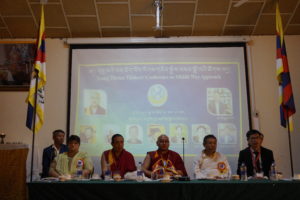Sara : Nestled within the thick foliages of the greeneries, College for Higher Tibetan Studies, Sarah, Dharamsala, saw the convergence of first-ever Young Tibetan Thinker’s Conference on Middle way Approach by Global Tibetan People’s Movement (GTPM) for Middle Way Approach on an idyllic Sunday of Oct 21 at 9 am.
Speaker of the 16th Tibetan Parliament-in-exile, Ven. Khenpo Sonam Tenphel attended the inauguration program as its ‘Chief-Guest’, who ignited the tradition Tibetan butter-lamp before the portrait of His Holiness the Dalai Lama.

The program began with a short-clip of His Holiness the Dalai Lama elucidating on Middle Way Approach, which was followed by GTPM’s President Mr. Lobsang Choephel briefing the attendees on the significance of comprehending the evolution of Middle Way Approach and its significant in relation to the geopolitics of international and Tibet-China context. He stated that Middle Way Approach, is an integral part of Tibet’s culture of compassion and non-voilence and that it is the best way to resolve the issue of Tibet with China.

Mr. Chodak Gyatso, Vice-President GTPM, briefed the conference on the aims, objectives and functions of Global Tibetan People’s Movement (GTPM) for Middle Way Approach.
Thereafter, Speaker Ven. Khnepo Sonam Tenphel took the stage to elaborate in detail the evolution of Middle Way Approach, delineating from the time of His Holiness the Dalai Lama along with 80,000 Tibetans’ exodus to exile in India in 1959 to the envision of a win-win proposition by His Holiness the Dalai Lama after a series of discussions with the Kashag (CTA/Tibetan cabinet members), leaders of the Tibetan Parliament-in-Exile (TPiE), and trusted friends of Tibet in 1974; to the subsequent evolution and changes till the present time.

He also briefed the conference on the nature Middle Way Approach’s political background by stating it was though a proposition envisioned by His Holiness the Dalai Lama, it was adopted with support from both the majority Tibetans and Tibetan Parliament in exile, democratically. He added that His Holiness has proposed a referendum of the Tibetan community be held for future dealings with China and to reorientate the course of the Tibetan freedom struggle, given the changing stances of Chinese government, which subsequently resulted in Tibetan Parliament in exile adopting the unanimous resolution that stated that His Holiness should, in the future, be the sole person to take decisions on Sino- Tibetan issues and that whatever decisions His Holiness the Dalai Lama takes will be regarded by all the Tibetan people as being the equivalent to a decision reached through a referendum, after the the preliminary opinion survey which reflected the Tibetan people’s profound trust in His Holiness the Dalai Lama in September 18, 1997.

He further said, ‘One must understand the reason as to why we are adopting this approach in today’s context. There are several reasons but lets just state two. One – For any country to adopt policy, be it as small as an economic policy, that country has to depend on the policies of other country. Lets take a look at European Union, which is a group of 28 countries that operates as a cohesive economic and political block. The member states sacrifices to ensure the great good of the whole union. Look at how member states uses Euro as their official currency letting go of their own. Depending on China by Tibet, whether independent or via Middle Way Approach, is imminent, for, an individual at the least or a nation by large cannot survive on its own without depending on others. Thats why MWA is appropriate and competent, on which you all can examine as well. Two – In today’s world. there are lots of countries that enjoy autonomy such as England, Canada, Italy etc, which are able to preserve the culture, tradition and language of their own people. Given the policies of Chinese government and the urgent situation inside Tibet, MWA, if considered, is an approach that would enable us to resolve the issues of Tibet. Therefore, its a viable approach to be adopted. One can also go through the official documents on Middle Way Approach, from Strasbourg Proposal in the European Parliament in 1988 to Memorandum on Genuine Autonomy for the Tibetan People presented during the 8th round of talks in October-November in 2008, which has undergone several changes. You can read on them, examine them. You can get publications on its evolution from Department of Information and International Relation for free.’
Speaking on international support for the approach, he stated that from European Parliament to White House of United States supports His Holiness’s proposal of Tibet-China resolution via dialogue, even the scholars and learned in mainland China renders their support to MWA by writing articles on it.
On the same context, Speaker stated that as often iterated by His Holiness the Dalai Lama, one must never cease to examine the competency and significance of Middle Way Approach, in context to the international geopolitics, China and Tibet. He added that MWA can be considered an ideology of high competence in today’s world, for its a policy that facilitates humanity, non-violence and leniency.
He concluded by requesting the young thinkers to pay more attention to the Middle Way Approach, to examine and research on it, so that they can contribute more in bridging the gap closer to the resolution of Tibet’s issues.






